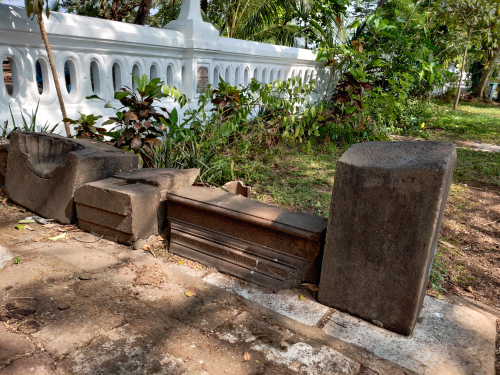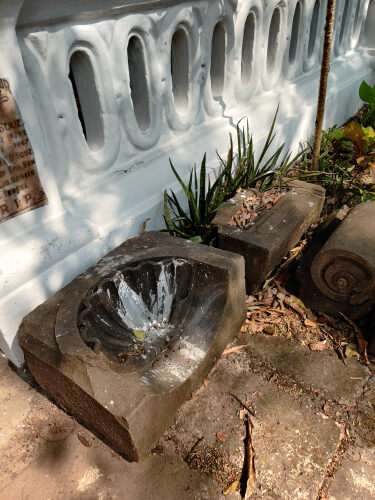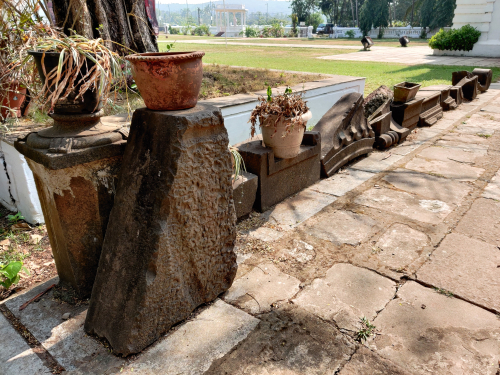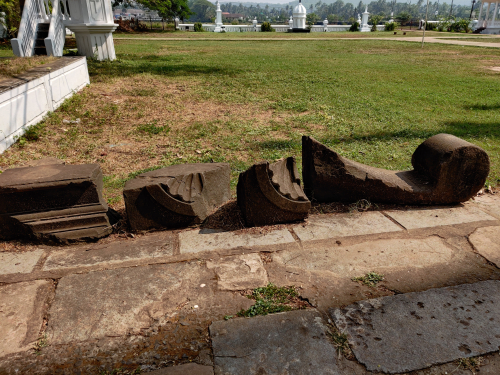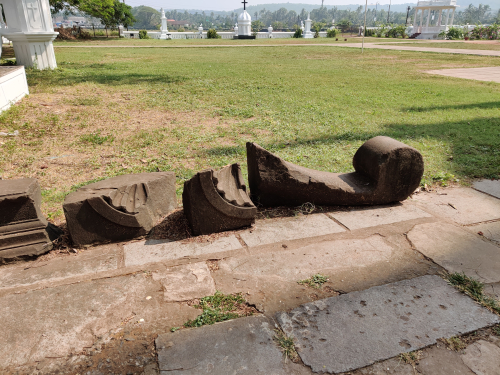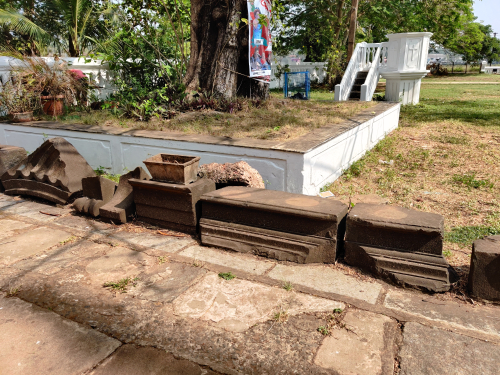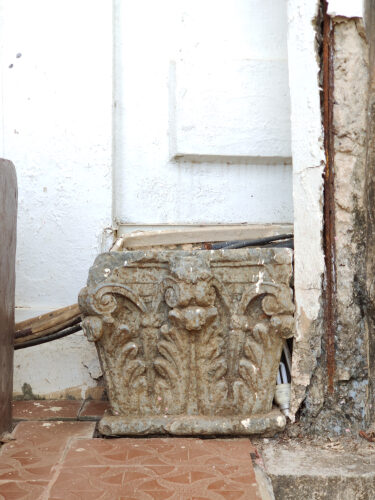DAUGIM AND SALIGAO
ONCE a thriving suburb of ‘Golden Goa’, Daugim is today a dreary waste. What was the abode of proud Fidalgos has been reduced to a ‘deserted village’, well exemplifying Oliver Goldsmith’s immortal lines:
“lll fares the land, to hast’ning ills a prey,
Where wealth accumulates, and men decay;
Princes and lords may flourish, or may fade;
A breath can make them, as a breath has made”.
But, though Daugim is dead, Saligao lives, and through Saligao Daugim also lives, for in Saligao Daugim is a living memory, and to live in the minds of men is not to die. A golden link – the beautiful image of our patroness, Mae de Deus – binds the two villages in an indissoluble union. Once the prized possession of Daugim, this miraculous image is today the priceless treasure of Saligao. Which true Christian Saligaokar can forget Daugim? If there be such , let him be anathema. Adapting the words of the Psalmist, he should rather say on bent knee:
If I forget thee, O Daugim,let my right hand forget its cunning.
If I do not remember thee, O Daugim let my tongue cleave to the palate.
Since we cannot forget Daugim, let us remember it as it was in its heyday. The old city of Goa had two suburbs – Daugim on its eastern side, Panelim on the western. A long double row of houses extended from the city to the convent of Madre de Deus. Another similar row of houses extended to Panelim ,and beyond as far as Ribandar.
Lying at the north-eastern extremity of the island of Tiswadi, Daugim commanded one of the principal passes to the mainland. As the Dutch traveller, Jan Huyghen van Linschoten, tells us in his Itinerario, “The third Passo on the South side of the Island , joyneth almost to the Towne, called ‘O Passo de Daugim’ or of Madre de Deus”. Thus, already when Linschoten was in Goa (1583-89), Daugim was also known as Madre de Deus, obviously after the church and convent of that name located there, just as Panelim was also called Sao Pedro after the church of St. peter built there.
Its geographical situation made Daugim an important point in the defence system of Old Goa, which was protected not only by the fortifications raised for the defence of the harbour, but also by the long wall, covering chiefly the eastern side of the island. This wall, completed early in the seventeenth century, began with a fort in the north- eastern part of the island at Daugim, and extended from that point to the church of Sao Braz, and was joined there to an old Mohammedan fort which had been rebuilt by the Portuguese, thence it proceeded to Banastarim, where it met the fortress of Sao Thiago.
Like Saligao in Bardez, Daugim was one of the first villages to be converted in Tiswadi. Here the movement towards Christianity manifested itself as early as 1540. This was the year in which the Hindu temples all over the Goa Islands were demolished by Royal order. Although there was much opposition to the destruction of the temples in many villages, we know from contemporary records that the people of Daugim, when they were still Hindus, pulled down their temple of their own accord and asked for a church dedicated to the Mother of God to be erected on its site. What was actually constructed, however, was a chapel of Madre de Deus. It was already in the existence in 1541, for it is mentioned in the list of chapels by Fernao Rodrigues de Castello-Branco, head of the Treasury, to which grants were made from the sum of 2000 tangas brancas, which the representative gaonkars of Tiswadi agreed to pay to the Treasury from the revenues of the lands attached to the destroyed temples.
According to the report of Miguel Vaz, the Vicar-General, by 1543 most of the villagers of Daugim had become Christians. Now, the question arises: who had converted them, for Miguel Vaz keeps us in the dark on the point. Fr. Achilles Meersman, O. F. M., in The Ancient Franciscan Provinces In India surmises, “ it may very well be that one or other Friar (Franciscan) had taken in the work of converting” these and other people in the vicinity. On the other hand, Fr. L. Frois, S. J., in his letter, dated 10 December 1560, seems to give the impression that missioning of Daugim and other villages around the city of Goa was done during the Viceroyalty of Dom Constantino de Braganca (1558-61) and the conversion of the people there was accomplished by the jesults. For, Fr. Frois writes, “ ………. He ( Dom Constantino) gave us the field and with the favour of God ……… the whole of Daugim became Christian……..”
Reading between the lines, however, we find that both the Franciscans and the Jesuits guel had a hand in the Christianization of Daugim. For, if Daugim was allocated as their mission -field by Dom Constantino Braganca (1568 – 61). The Jesuits alone could not have been responsible for converting all the people of Daugim. We know from Miguel Vaz’s report that already by 1543 almost the whole village of Daugim was converted, and this was probably due to the Franciscans. However, it is certain that the Jesuits completed the work of conversion. How this came about we know from an incident recorded in contemporary Jesuits sources. It so happened that the Portuguese thanadar of the place knew Konkani and was regarded by the people as “their friend and father”. The Jesuit scholastic who taught catechism at Daugim requested the Portuguese official to try to persuade the remaining Hindu families. Accordingly, he invited the men to a dinner in his own house on 19 July 1560, while his mother gathered the women in another. The thanadar addressed them in Konkani and they all expressed their desire to enter the Christian fold, “Daugim being thus”, as Fr. Anthony D’Costa says, “the first village to become almost entirely Christian”.
It was at Daugim that in 1569 the Franciscans built their first Retiro or House of Seclusion for the Custody of St. Thomas, the mother-house of which was the friary of St. Francis of Assisi at Old Goa. Why Daugim was selected as the site for the first Franciscan House of Recollection and why it came to be called the Retiro of Madre de Deus call for an explanation. It appeared to the founders that Daugim was ideally situated for locating a house of recollection, for it was some distance away from the city to provide the necessary quiet but not too far from the convent of St. Francis of Assisi for the Retiro friars to be able to visit it without much difficulty.
It has, however, been said that, since Daugim occupied a strategic position, the Friary was built there to serve as an observation or defensive outpost in case of an invasion of the island. As a matter of fact, the Friary was time and again used as a part of Goa’s defenses, but Fr. Achilles Meersman very much doubts ‘whether the Archbishop (Dom Gaspar de Leao Pereira) and the Custos (Friar Paulino de Anaia) had anything so warlike in mind when they selected the site. The fact that it lay in a solitary place must have been the decisive factor”.
So far as we are concerned, much more important than the reason for the location of the Retiro at Daugim, is how it came to be dedicated to the Mother of God. According to Friar Amaro de S. Antonio, the writer of the introduction to the Franciscan chapter-lists, it was Archbishop Gaspar who, in a moment of inspiration, chose the Mother of God as the patroness of the Retiro. The Archbishop may have indeed proposed the name, but there is no need to presume that he was inspired to do so,for, as we have seen, there was already a chapel dedicated to the Mother of God at Daugim, just as the late Anacleto Lobo did not have to be inspired to name the school that he founded at Saligao as ‘Mater Dei’, when Mae de Deus was already the patroness of our village.
The Friary of Madre de Deus was inaugurated on October 31, 1569. The members of the new Retiro were taken in solemn procession to their new abode, with the Archbishop of Goa, the Custos of the St. Thomas Custody, the Cathedral Chapel and the whole community of the convent of St. Francis of Assisi joining it. This Retiro of Daugim eventually became the mother-house, first of the custody, and later of the province of Madre de Deus. Attached to the friary of Daugim was the church of Madre de Deus with the beautiful statue, which today is the chief ornament of Saligao church, adoring its main alter. To the best of our knowledge, the statue is about 400 years old. The year 1973 could, therefore, be taken to mark not only the first centenary of our church but also the fourth centenary of the statue of Mae de Deus that finds an honored niche therein.
In the beginning the Friary of Daugim served as a house of recollection of the St. Thomas Custody. Those friars who were more inclined towards contemplation than evangilization volunteered to reside at Daugim. Other friars would reside there for longer or shorter period, according to their needs. Soon however, the Retiro at Daugim began to accept candidates who opted for this form of Franciscan life. Accordingly a novitlate and course of studies were started. These continued to function up to the end, though when new retiros were founded elsewhere, part of the studies were transferred thither or similar courses initiated.
When the two Franciscan Provinces of St. Thomas and Madre de Deus emerged, the difference of observance between them was that, while the primary object of the former was evangilization, that of the latter was contemplation. This is, however, only a broad generalization. As Friar Achilles Meersman says,”……..it would not do to exaggerate these differences as if the one was exclusively active and the other purely contemplative. There were elements of each in both modes of life.”
One of the activities which the friars of the Madre de Deus Province found well suited to their mode of life was the maintenance of dispensaries at their Retiros, including one at Daugim, whither the sick, chiefly the poor, flocked. This Province produced a number of men who were well-versed in contemporary medicine. After the suppression of the Jesuit Order in the Portuguese dominions by Marques de Pombal, the Jesuits passed on the secret of the pedras cordeas, popularly known as Goa stones-a supposedly potent remedy, to the Daugim Friars, and they were prepared in their pharmacy till 1835. The reason why the Jesuits,at their suppression, disclosed the secret of the pedras cordeas to the Daugim Friars is not only because they maintained dispensaries, but also because, of all the Religious in Goa with whom the Jesuits were housed before they were transported to the prisons of Portugal,the Daugim Friars treated them the best.
Given their mode of life, it is not surprising that the Friars of the Madre de Deus Province enjoyed a good reputation. The following extract from a general letter of the Viceroy, Dom Miguel de Noronha, Conde de Linhares, to the King, Dom Felipe III, dated 13 December 1634, indicates the kind of life the Retiro Friars led and the type of work that they did :”As far as the Friars are concerned to Whom Your Highness refers they seem to be useful in India, for their Order is very rigorous and they lead exemplary lives. They attend to the sick at the Piedade Hospital with great humility and danger to their lives. They go to the interior to care for the way- Ward, having converted many to our holy faith.”
Unfortunately, not much concerning the history of the Daugim Convent has come down to us. However, Fr. Paulo da Trindade In the Chronicle which he completed about 1636, gives thumb-nail
sketches of a number of saintly Friars who either died or, for a time, resided there during the early period of its existence. From the brief summaries of their lives, it appears that many a Friar lived up to ideals which inspired the founders of the Retiro of Madre de Deus at Daugim.
We have little information about the kind of personal life the Daugim Friars led in the later period. But even if the life they lived was an exemplary as that of their earlier predecessors, they could not save themselves from the disastrous tidal wave of Suppression that swept away all the remaining Religious Houses in Goa in 1835. By the time, however, Daugim was not even a shadow of its once glorious self. With the decay and death of ‘Golden Goa’, Daugim already bore the aspect of a deserted village. Where were the Fidalgos of yester-year?
All the movable and immovable property of the Retiro of Daugim was confiscated by the State, which appointed caretakers. But since Government could not spare the funds required lo keep it in
repair, it fell into ruin, and eventually the question of disposing of the effects arose. The Church-funishings were distributed among various churches in Goa —— the statue of Mae de Deus, to Saligao the pulpit and two reredos to Mapuca, one of the bells and the organ to Moira, another bell to Jua, and two reredos to Assolna. The remains o the two bishops, Dom Gaspar d Leao Pereira, the first Archbishop of Goa and one of the principal founders of the Retiro of Daugim, and Dom Andre de S. Maria, O. F. M., who were buried there, were exhumed and reburied in the Cathedral of Goa. A common slab with an inscription marks the spot in Se primacial. The remainder of the inscribed slabs covering the graves of those who were interred in the church of Madre de Deus were collected and deposited in Museo Real da India Portugueza. By 1878 the Friary had almost disappeared and the Church was in a tottering condition. Finally, what was left of the Friary and the Church after years of neglect was razed to the ground. A cross was erected to mark the site where once stood in heavenly splendour the convent and church of Madre de Deus.

